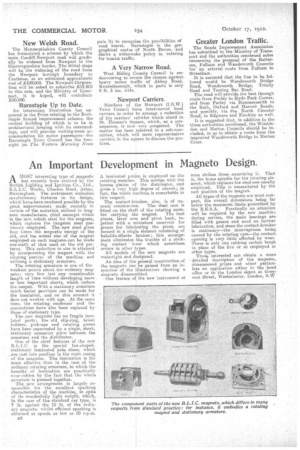An Important Development in Magneto Design.
Page 8

If you've noticed an error in this article please click here to report it so we can fix it.
AMOST interesting type of magneto has recently been evolved by the British Lighting and Ignition Co., Ltd., B.L.I.C. Works, Cheston Road, Aston, Birmingham. The instrument embodies revolutionary features in its design, which have been rendered possible by the great improvements made recently in certain cia the materials utilized in megneto manufacture, chief amongst which is the new cobalt steel for the magnets, which replaces the tungsten steel previously employed. The new steel gives four times the magnetic energy of the old, and tale actual size of the magnet employed on each magneto-can be made one-sixth of that used on the old patterns. This reduction in size is attained by incorporating the magnet with the rotating portioa of the machine and utilizing a stationary armature.
The rotating armature is one of the weakest points about the ordinary magneto • very few last any considerable length of time without developing more or less important shorts, which reduce the output. With a stationary armature much better prevision can be made for the insulation, and on this account it does not weaken with age. At the same time, the rotating condenser and the connections have also been replaced by those of stationary type. The new Magneto has no fragile insulated parts; the old slip-ring, brush holders, pick-ups and rotating pieces have been superseded by a single, short, stationary connecter piece between the armature and the distributor.
One of the chief features of the new is the special fan-shaped, stationary laminated pole shoes, which are cast into position in the Main casing of the magneto. The lamination is far more effective than in the case of the ordinary rotating armature, in which the benefits of lamination are practically over-ridden by the fact that the whole armature is pressed together. The new arrangement is largely responsible for the excellent sparking characteristics of the machine, m spite of its wonderfully light weight, which, in the case of the standard car type, is 7 lb.. against the 15 lb. of the ordinary magneto, whilst efficient sparking is obtained at speeds as low as 50 r.p.m.
B8 A laminated pinion is employed on the rotating member. This meshes with the bronze pinion of the distributer, and gives a very high degree of silence; in fact, the whole machine is remarkable in this respect. The contact-breaker, also, is of un usual construction. The steel cam is fitted on the shaft of the rotating mem ber carrying the magnet. The heel pieces, lever arm and pivot bush, together with a miniature reservoir for grease for lubricating the pivot, are formed in a single element consisting of bakelite-dilecto lam inn; this arrangemeat eliminates the trouble of a stick-, ing contact • lever which sometimes occurs in other types.
All modals of the new magneto are watertight and dustproof.
An idea of the general construction of the magneto can be gained from an inspection of the illustrations showing a magneto disassembled. 'One feature of the new instrument at once strikes those .examining it. That is, the brass spindle far the rotating element, which replaces the steel one usually employed. This is necessitated by the new position of the magnet.
All types of the magneto are most compact, the overall ditrienSions being far below the maximum limits prescribed by the B.E.S.A. Practically no attention will be required by the new niachina during service, the main bearings are filled with grease and need no further lubrication, and since the contact_breaker is stationary—the interruptions being caused by the rotating cam—the contact opening is very little affected by wear. There is only one rubbing carbon brush in place of the five or so employed in other types. Those interested can obst-ain a more detailed description of the magneto, dimensioned prints and other particulars on application either to the head office or to the London depot at Greycoat Street, Westminster, London, SW,
































